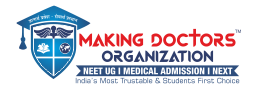
The best choice for USMLE coaching
USMLE
MDO is an organization that provides coaching and test preparation services for medical students and doctors who are preparing to take the USMLE (United States Medical Licensing Examination).
MDO claims to have a team of experienced and knowledgeable instructors who use the latest teaching methods and technology to help students prepare for the USMLE.

Get Online Consultation!
Achieving a globally recognized MBBS degree can help you fulfill your dreams.
Know more about USMLE
Making Doctors Organization for USMLE
-
Eligibility
-
Eligibility
To be eligible to take the United States Medical Licensing Examination (USMLE), you must meet the following criteria:
You must be a medical student or graduate of a medical school that is accredited by the Liaison Committee on Medical Education (LCME) or the Commission on Osteopathic College Accreditation (COCA).
You must have completed or be in the process of completing the required medical education as determined by the state medical board where you plan to practice medicine.
You must be in good standing with your medical school or have graduated from medical school.
You must have the necessary identification documents, such as a passport or driver’s license.
You must register for and pay the appropriate fees for each USMLE Step that you plan to take.
It is important to note that each state medical board may have additional requirements for licensure beyond passing the USMLE. Additionally, some medical schools may have their own requirements for students to be eligible to take the USMLE, so it is important to check with your school and state medical board for specific eligibility requirements.
-
Course detail
-
Course Details
The United States Medical Licensing Examination (USMLE) is a three-step exam that assesses a physician’s ability to apply knowledge, concepts, and principles, and to demonstrate fundamental patient-centered skills that are important in health and disease. Here are the course details for each of the three steps:
Step 1: This exam focuses on assessing a physician’s ability to apply basic science concepts to the practice of medicine. The exam consists of approximately 280 multiple-choice questions and is typically taken by medical students after they have completed their second year of medical school. The test is administered over one day and takes approximately eight hours to complete.
Step 2: This exam is divided into two parts: Clinical Knowledge (CK) and Clinical Skills (CS). The CK portion is a multiple-choice exam that assesses a physician’s ability to apply clinical knowledge to patient care. The CS portion is a standardized patient-based exam that assesses a physician’s ability to communicate effectively with patients and to perform clinical skills. The CK portion is typically taken after the third year of medical school, while the CS portion is taken during the fourth year. The CK portion is administered over one day and takes approximately nine hours to complete, while the CS portion is administered over two days and takes approximately eight hours to complete.
Step 3: This exam assesses a physician’s ability to apply medical knowledge and understanding of biomedical and clinical science to the unsupervised practice of medicine. The exam consists of approximately 300 multiple-choice questions and is typically taken during the first or second year of residency training. The test is administered over two days and takes approximately 14 hours to complete.
It is important to note that the course details for each step of the USMLE are subject to change, so it is recommended to check the official USMLE website for the most up-to-date information.
-
Key-points
-
Key-points for USMLE
The United States Medical Licensing Examination (USMLE) is a comprehensive and challenging exam that requires significant preparation and study. Here are some key points to keep in mind as you prepare for the exam:
Content: The USMLE is designed to assess a physician’s ability to apply knowledge, concepts, and principles in health and disease. The exam covers a wide range of topics, including basic science concepts, clinical knowledge, and patient-centered skills.
Format: The USMLE is a computer-based exam that consists of multiple-choice questions and patient simulations. The exam is divided into three steps, each with its own format and content.
Preparation: Preparing for the USMLE requires a significant amount of time and effort. It is important to develop a study plan that includes review of basic science concepts, clinical knowledge, and patient-centered skills. Many test-takers find it helpful to use review books, study guides, and online resources to supplement their learning.
Timing: It is important to plan ahead and give yourself enough time to prepare for each step of the USMLE. Each step of the exam is administered on a specific schedule, and it may take several months to complete all three steps.
Scoring: The USMLE is a pass/fail exam, and the passing score varies for each step. It is important to understand the scoring system and to aim for a score that meets or exceeds the passing threshold.
Eligibility: To be eligible to take the USMLE, you must meet certain requirements, including completion of medical education at an accredited institution, good standing with your medical school, and appropriate identification documents.
Registration: You must register for each step of the USMLE and pay the appropriate fees. Registration deadlines and fees may vary depending on the step of the exam and your location.
Overall, the USMLE is a challenging exam that requires careful preparation, dedication, and hard work. By keeping these key points in mind and following a structured study plan, you can increase your chances of success on the exam.
-
Entrance Test
-
Pattern of the Entrance Test
Step 1:
- One-day exam
- Approximately 280 multiple-choice questions
- Seven 60-minute blocks
- Eight hours total testing time
- Questions designed to test basic science concepts
Step 2:
- Divided into two parts: Clinical Knowledge (CK) and Clinical Skills (CS)
- CK portion is a one-day exam
- Approximately 318 multiple-choice questions
- Eight 60-minute blocks
- Nine hours total testing time
- Questions designed to test clinical knowledge
- CS portion is a patient-based exam
- Assesses physician’s ability to communicate effectively with patients and to perform clinical skills
Step 3:
- Two-day exam
- Approximately 300 multiple-choice questions
- Two 45-minute sessions with 40 questions each
- Thirteen 60-minute blocks with up to 30 questions each
- Fourteen hours total testing time
- Questions designed to assess a physician’s ability to apply medical knowledge and understanding of biomedical and clinical science to the unsupervised practice of medicine.
It is important to note that the USMLE exam pattern may be subject to change, so it is recommended to check the official USMLE website for the most up-to-date information.
Eligibility
To be eligible to take the United States Medical Licensing Examination (USMLE), you must meet the following criteria:
You must be a medical student or graduate of a medical school that is accredited by the Liaison Committee on Medical Education (LCME) or the Commission on Osteopathic College Accreditation (COCA).
You must have completed or be in the process of completing the required medical education as determined by the state medical board where you plan to practice medicine.
You must be in good standing with your medical school or have graduated from medical school.
You must have the necessary identification documents, such as a passport or driver’s license.
You must register for and pay the appropriate fees for each USMLE Step that you plan to take.
It is important to note that each state medical board may have additional requirements for licensure beyond passing the USMLE. Additionally, some medical schools may have their own requirements for students to be eligible to take the USMLE, so it is important to check with your school and state medical board for specific eligibility requirements.
Course Details
The United States Medical Licensing Examination (USMLE) is a three-step exam that assesses a physician’s ability to apply knowledge, concepts, and principles, and to demonstrate fundamental patient-centered skills that are important in health and disease. Here are the course details for each of the three steps:
Step 1: This exam focuses on assessing a physician’s ability to apply basic science concepts to the practice of medicine. The exam consists of approximately 280 multiple-choice questions and is typically taken by medical students after they have completed their second year of medical school. The test is administered over one day and takes approximately eight hours to complete.
Step 2: This exam is divided into two parts: Clinical Knowledge (CK) and Clinical Skills (CS). The CK portion is a multiple-choice exam that assesses a physician’s ability to apply clinical knowledge to patient care. The CS portion is a standardized patient-based exam that assesses a physician’s ability to communicate effectively with patients and to perform clinical skills. The CK portion is typically taken after the third year of medical school, while the CS portion is taken during the fourth year. The CK portion is administered over one day and takes approximately nine hours to complete, while the CS portion is administered over two days and takes approximately eight hours to complete.
Step 3: This exam assesses a physician’s ability to apply medical knowledge and understanding of biomedical and clinical science to the unsupervised practice of medicine. The exam consists of approximately 300 multiple-choice questions and is typically taken during the first or second year of residency training. The test is administered over two days and takes approximately 14 hours to complete.
It is important to note that the course details for each step of the USMLE are subject to change, so it is recommended to check the official USMLE website for the most up-to-date information.
Key-points for USMLE
The United States Medical Licensing Examination (USMLE) is a comprehensive and challenging exam that requires significant preparation and study. Here are some key points to keep in mind as you prepare for the exam:
Content: The USMLE is designed to assess a physician’s ability to apply knowledge, concepts, and principles in health and disease. The exam covers a wide range of topics, including basic science concepts, clinical knowledge, and patient-centered skills.
Format: The USMLE is a computer-based exam that consists of multiple-choice questions and patient simulations. The exam is divided into three steps, each with its own format and content.
Preparation: Preparing for the USMLE requires a significant amount of time and effort. It is important to develop a study plan that includes review of basic science concepts, clinical knowledge, and patient-centered skills. Many test-takers find it helpful to use review books, study guides, and online resources to supplement their learning.
Timing: It is important to plan ahead and give yourself enough time to prepare for each step of the USMLE. Each step of the exam is administered on a specific schedule, and it may take several months to complete all three steps.
Scoring: The USMLE is a pass/fail exam, and the passing score varies for each step. It is important to understand the scoring system and to aim for a score that meets or exceeds the passing threshold.
Eligibility: To be eligible to take the USMLE, you must meet certain requirements, including completion of medical education at an accredited institution, good standing with your medical school, and appropriate identification documents.
Registration: You must register for each step of the USMLE and pay the appropriate fees. Registration deadlines and fees may vary depending on the step of the exam and your location.
Overall, the USMLE is a challenging exam that requires careful preparation, dedication, and hard work. By keeping these key points in mind and following a structured study plan, you can increase your chances of success on the exam.
Pattern of the Entrance Test
Step 1:
- One-day exam
- Approximately 280 multiple-choice questions
- Seven 60-minute blocks
- Eight hours total testing time
- Questions designed to test basic science concepts
Step 2:
- Divided into two parts: Clinical Knowledge (CK) and Clinical Skills (CS)
- CK portion is a one-day exam
- Approximately 318 multiple-choice questions
- Eight 60-minute blocks
- Nine hours total testing time
- Questions designed to test clinical knowledge
- CS portion is a patient-based exam
- Assesses physician’s ability to communicate effectively with patients and to perform clinical skills
Step 3:
- Two-day exam
- Approximately 300 multiple-choice questions
- Two 45-minute sessions with 40 questions each
- Thirteen 60-minute blocks with up to 30 questions each
- Fourteen hours total testing time
- Questions designed to assess a physician’s ability to apply medical knowledge and understanding of biomedical and clinical science to the unsupervised practice of medicine.
It is important to note that the USMLE exam pattern may be subject to change, so it is recommended to check the official USMLE website for the most up-to-date information.
Why Making Doctors Organization for USMLE?
- Experienced faculty with in-depth knowledge of USMLE exam patterns and content.
- Customized study plans tailored to meet individual student needs.
- Interactive and engaging teaching methods.
- Comprehensive study material and resources.
- Consistent track record of high success rates.
- Affordable pricing options for coaching services.
- Ongoing support and guidance throughout the exam preparation process.














